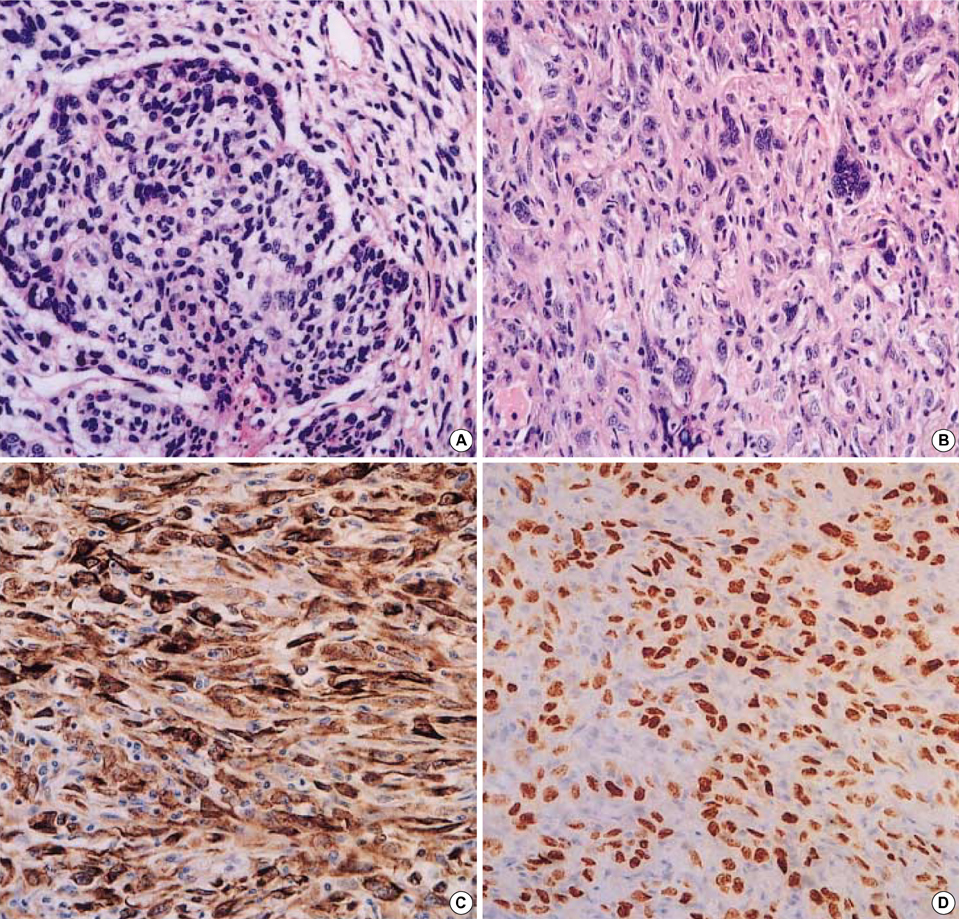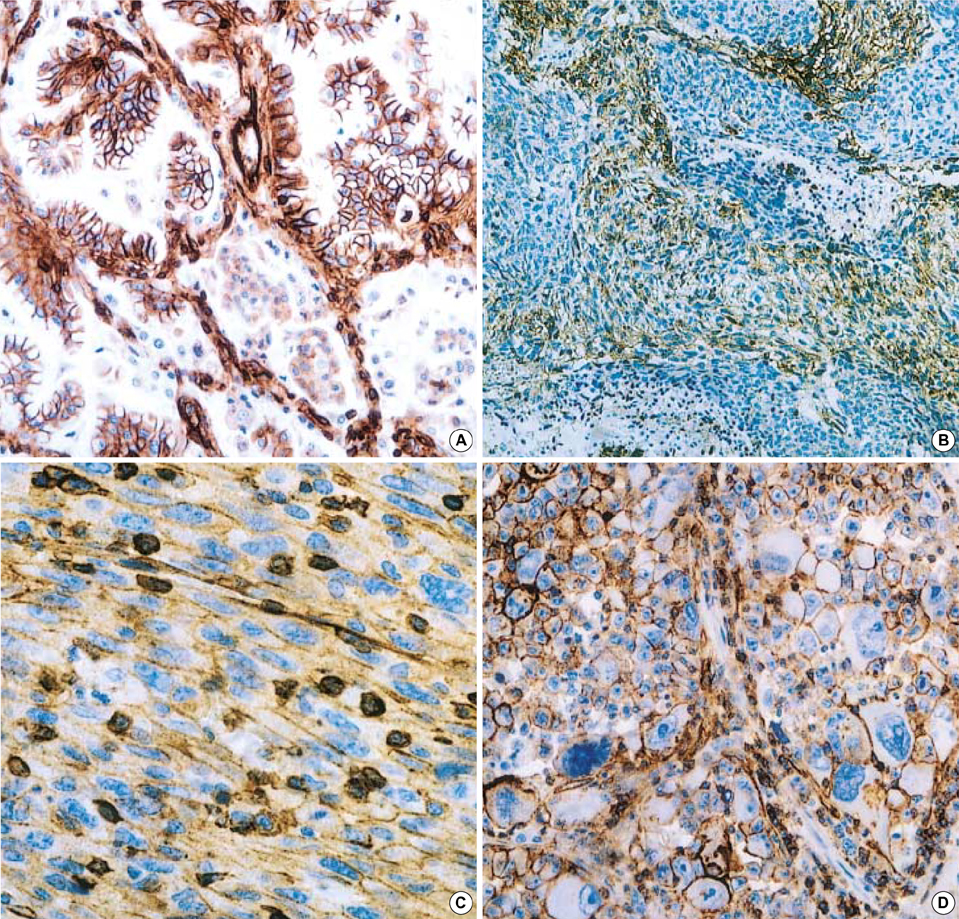J Korean Med Sci.
2005 Feb;20(1):50-55. 10.3346/jkms.2005.20.1.50.
Expression of CD99 in Pleomorphic Carcinomas of the Lung
- Affiliations
-
- 1Department of Pathology Seoul National University College of Medicine, Seoul, Korea. doohyun@plaza.snu.ac.kr
- 2Xenotransplantation Research Center Seoul National University College of Medicine, Seoul, Korea.
- 3Department of Pathology, Sungkyunkwan University School of Medicine, Seoul, Korea.
- KMID: 1781724
- DOI: http://doi.org/10.3346/jkms.2005.20.1.50
Abstract
- Pleomorphic carcinoma of the lung (PCL) is characterized by a mixture of sarcomatoid and carcinoma components, and a poor prognosis. However, no immunophenotype of tumor markers has been characterized in PCL. To charaterize the immunophenotype for CD99 in PCL, we performed an immunohistochemical evaluation of PCLs for thyroid transcription factor-1 (TTF-1), cytokeratin (CK) 7 and 20, and for CD99. CD99 was found to be expressed in both carcinomatous (47%) and sarcomatous components such as spindle cells (92%) and giant cells (57%). In the case of spindle cells, CK7 was expressed in 6 cases (46%) and TTF-1 in 2 cases (15%), whereas for giant cells CK7 was expressed in 8 cases (57%) and TTF-1 in one case (7%). However, CK20 was not expressed in either the carcinomatous or sarcomatous components in any case. Thus, CD99 was found to be widely expressed in both sarcomatous and carcinoma component in PCL. A clinicopathological analysis showed no direct correlation between the expression of CD99 and the clinical indices (stage, survival rate, invasion) of PCL.
MeSH Terms
-
Adult
Aged
Aged, 80 and over
Antigens, CD/*biosynthesis
Carcinoma/*metabolism
Cell Adhesion Molecules/*biosynthesis
Female
Humans
Immunohistochemistry
Immunophenotyping
Intermediate Filament Proteins/biosynthesis
Keratin/biosynthesis
Lung Neoplasms/*metabolism
Male
Middle Aged
Nuclear Proteins/biosynthesis
Prognosis
Research Support, Non-U.S. Gov't
Sarcoma/metabolism
Time Factors
Transcription Factors/biosynthesis
Figure
Cited by 1 articles
-
Immunoreactivity of CD99 in Non-Hodgkin's Lymphoma: Unexpected Frequent Expression in ALK-positive Anaplastic Large Cell Lymphoma
Chang Ohk Sung, Young H. Ko, Sanghui Park, Kihyun Kim, Wonseog Kim
J Korean Med Sci. 2005;20(6):952-956. doi: 10.3346/jkms.2005.20.6.952.
Reference
-
1. Brambilla E, Travis WD, Colby TV, Corrin B, Shimosato Y. The new World Health Organization classification of lung tumours. Eur Respir J. 2001. 18:1059–1068.
Article2. Travis WD. Pathology of lung cancer. Clin Chest Med. 2002. 23:65–81.
Article3. Travis WD, Travis LB, Devesa SS. Lung cancer. Cancer. 1995. 75:191–202.
Article4. Travis WD, Colby TV, Corrin B. Histopathological Typing of Lung and Pleural Tumours. 1999. New York: Springer Verlag.5. Addis BJ, Corrin B. Pulmonary blastoma, carcinosarcoma and spindle-cell carcinoma: an immunohistochemical study of keratin intermediate filaments. J Pathol. 1985. 147:291–301.
Article6. Battifora H. Spindle cell carcinoma: ultrastructural evidence of squamous origin and collagen production by the tumor cells. Cancer. 1976. 37:2275–2282.7. Berho M, Moran CA, Suster S. Malignant mixed epithelial/mesenchymal neoplasms of the lung. Semin Diagn Pathol. 1995. 12:123–139.8. Cagle PT, Alpert LC, Carmona PA. Peripheral biphasic adenocarcinoma of the lung: light microscopic and immunohistochemical findings. Hum Pathol. 1992. 23:197–200.
Article9. Chang YL, Lee YC, Shih JY, Wu CT. Pulmonary pleomorphic (spindle) cell carcinoma: peculiar clinicopathologic manifestations different from ordinary non-small cell carcinoma. Lung Cancer. 2001. 34:91–97.
Article10. Attanoos RL, Papagiannis A, Suttinont P, Goddard H, Papotti M, Gibbs AR. Pulmonary giant cell carcinoma: pathological entity or morphological phenotype? Histopathology. 1998. 32:225–231.
Article11. Fishback NF, Travis WD, Moran CA, Guinee DG Jr, McCarthy WF, Koss MN. Pleomorphic (spindle/giant cell) carcinoma of the lung. A clinicopathologic correlation of 78 cases. Cancer. 1994. 73:2936–2945.
Article12. Nakajima M, Kasai T, Hashimoto H, Iwata Y, Manabe H. Sarcomatoid carcinoma of the lung: a clinicopathologic study of 37 cases. Cancer. 1999. 86:608–616.13. Nappi O, Glasner SD, Swanson PE, Wick MR. Biphasic and monophasic sarcomatoid carcinomas of the lung. A reappraisal of 'carcinosarcomas' and 'spindle-cell carcinomas'. Am J Clin Pathol. 1994. 102:331–340.14. Ambros IM, Ambros PF, Strehl S, Kovar H, Gadner H, Salzer-Kuntschik M. MIC2 is a specific marker for Ewing's sarcoma and peripheral primitive neuroectodermal tumors. Evidence for a common histogenesis of Ewing's sarcoma and peripheral primitive neuroectodermal tumors from MIC2 expression and specific chromosome aberration. Cancer. 1991. 67:1886–1893.
Article15. Kovar H, Dworzak M, Strehl S, Schnell E, Ambros IM, Ambros PF, Gadner H. Overexpression of the pseudoautosomal gene MIC2 in Ewing's sarcoma and peripheral primitive neuroectodermal tumor. Oncogene. 1990. 5:1067–1070.16. Delattre O, Zucman J, Melot T, Garau XS, Zucker JM, Lenoir GM, Ambros PF, Sheer D, Turc-Carel C, Triche TJ, Aurias A, Thomas G. The Ewing family of tumors--a subgroup of small-round-cell tumors defined by specific chimeric transcripts. N Engl J Med. 1994. 331:294–299.17. Ozdemirli M, Fanburg-Smith JC, Hartmann DP, Azumi N, Miettinen M. Differentiating lymphoblastic lymphoma and Ewing's sarcoma: lymphocyte markers and gene rearrangement. Mod Pathol. 2001. 14:1175–1182.
Article18. Costa MJ, Ames PF, Walls J, Roth LM. Inhibin immunohistochemistry applied to ovarian neoplasms: a novel, effective, diagnostic tool. Hum Pathol. 1997. 28:1247–1254.
Article19. Pelosi G, Fraggetta F, Sonzogni A, Fazio N, Cavallon A, Viale G. CD99 immunoreactivity in gastrointestinal and pulmonary neuroendocrine tumours. Virchows Arch. 2000. 437:270–274.
Article20. Jung KC, Kim NH, Park WS, Park SH, Bae Y. The CD99 signal enhances Fas-mediated apoptosis in the human leukemic cell line, Jurkat. FEBS Lett. 2003. 554:478–484.
Article21. Fisher C. Synovial sarcoma. Ann Diagn Pathol. 1998. 2:401–421.
Article22. Gordon MD, Corless C, Renshaw AA, Beckstead J. CD99, keratin, and vimentin staining of sex cord-stromal tumors, normal ovary, and testis. Mod Pathol. 1998. 11:769–773.23. Shin YK, Lee GK, Kook MC, Jung KC, Kim JR, Song HG, Park SH, Chi JG. Reduced expression of CD99 and functional disturbance in anencephalic cortical thymocytes. Virchows Arch. 1999. 434:443–449.
Article24. Matias-Guiu X, Pons C, Prat J. Mullerian inhibiting substance, alpha-inhibin, and CD99 expression in sex cord-stromal tumors and endometrioid ovarian carcinomas resembling sex cord-stromal tumors. Hum Pathol. 1998. 29:840–845.
Article25. Weidner N, Tjoe J. Immunohistochemical profile of monoclonal antibody O13: antibody that recognizes glycoprotein p30/32MIC2 and is useful in diagnosing Ewing's sarcoma and peripheral neuroepithelioma. Am J Surg Pathol. 1994. 18:486–494.26. Granter SR, Renshaw AA, Fletcher CD, Bhan AK, Rosenberg AE. CD99 reactivity in mesenchymal chondrosarcoma. Hum Pathol. 1996. 27:1273–1276.
Article27. Jung KC, Park WS, Bae YM, Hahn JH, Hahn K, Lee H, Lee HW, Koo HJ, Shin HJ, Shin HS, Park YE, Park SH. Immunoreactivity of CD99 in stomach cancer. J Korean Med Sci. 2002. 17:483–489.
Article28. Lee EJ, Lee HG, Park SH, Choi EY, Park SH. CD99 type II is a determining factor for the differentiation of primitive neuroectodermal cells. Exp Mol Med. 2003. 35:538–547.
Article29. Lee IS, Kim SH, Song HG, Park SH. The molecular basis for the generation of Hodgkin and Reed-Sternberg cells in Hodgkin's lymphoma. Int J Hematol. 2003. 77:330–335.
Article30. Lee HJ, Kim E, Jee B, Hahn JH, Han K, Jung KC, Park SH, Lee H. Functional involvement of src and focal adhesion kinase in a CD99 splice variant-induced motility of human breast cancer cells. Exp Mol Med. 2002. 34:177–183.
Article31. Lee IS, Shin YK, Chung DH, Park SH. LMP-1 induced downregulation of CD99 molecules in Hodgkin's and Reed-Sternberg cells. Leuk Lymphoma. 2001. 42:587–594.32. Sohn HW, Choi EY, Kim SH, Lee IS, Chung DH, Sung UA, Hwang DH, Cho SS, Jun BH, Jang JJ, Chi JG, Park SH. Engagement of CD99 induces apoptosis through calcineurin-independent pathway in Ewing's sarcoma cells. Am J Pathol. 1998. 153:1937–1945.33. Kim SH, Choi EY, Shin YK, Kim TJ, Chung DH, Chang SI, Kim NK, Park SH. Generation of cells with Hodgkin's and Reed-Sternberg phenotype through downregulation of CD99 (MIC2). Blood. 1998. 92:4287–4295.
Article34. Rossi G, Cavazza A, Sturm N, Migaldi M, Facciolongo N, Longo L, Maiorana A, Brambilla E. Pulmonary carcinomas with pleomorphic, sarcomatoid, or sarcomatous elements: a clinicopathologic and immunohistochemical study of 75 cases. Am J Surg Pathol. 2003. 27:311–324.35. Dacic S, Finkelstein SD, Sasotomi E, Swalsky PA, Yousem SA. Molecular pathogenesis of pulmonary carcinosarcoma as determined by microdisection-based allelotyping. Am J Surg Pathol. 2002. 26:510–516.36. Holst VA, Finkelstein S, Colby TV, Myers JL, Yousem SA. p53 and K-ras mutational genotyping in pulmonary carcinosarcoma, spindle cell carcinoma, and pulmonary blastoma: implication for histogenesis. Am J Surg Pathol. 1997. 21:801–811.37. Thompson L, Chang B, Barsky SH. Mononclonal origins of malignant mixed tumors (carcinosarcomas): evidence for a divergent histogenesis. Am J Surg Pathol. 1996. 20:277–285.
- Full Text Links
- Actions
-
Cited
- CITED
-
- Close
- Share
- Similar articles
-
- The Correlation between the Expression of CD99 and the Cell Cycle
- The increased expression of CD99 in a differentiated neuroblastoma cell line
- p53 Expression in the Head and Neck Tumor
- CD99 Is Strongly Expressed in Basal Cells of the Normal Adult Epidermis and Some Subpopulations of Appendages: Comparison with Developing Fetal Skin
- The Distribution of MIC2 Antigen (CD99) Expression on Various Mucosa-Associated Lymphoid Tissue of Human Embryos and Fetuses



